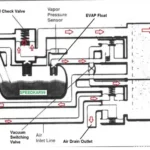Toyota Mirai, the trailblazing hydrogen fuel cell vehicle heralded as a potential game-changer in the automotive industry, has encountered challenges that have hindered its widespread adoption. To unravel the reasons behind Toyota Mirai’s inability to ignite the fuel cell revolution, we must delve into the complexities of hydrogen fuel cell technology and its interplay with the automotive landscape. By examining the infrastructure obstacles, evaluating the economics, and comparing Mirai’s performance to rivals, we gain insights into the factors that have shaped its trajectory. Furthermore, we explore the potential of hydrogen fuel cells in light of emerging electric vehicle technology and sustainable mobility strategies, considering alternative pathways for a greener future.
Why Did Toyota Mirai Fail to Ignite the Fuel Cell Revolution?
Why Toyota Mirai Failed to Ignite the Fuel Cell RevolutionDespite Toyota’s ambitious vision for hydrogen fuel cell technology, the Mirai has struggled to gain traction in the automotive market. While fuel cell technology holds great promise for clean and efficient transportation, several key challenges have hindered its widespread adoption. One major obstacle is the lack of a comprehensive hydrogen fueling infrastructure. Without a sufficient network of fueling stations, it can be inconvenient and time-consuming to refuel a fuel cell vehicle, which can deter potential buyers.
Furthermore, the high cost of hydrogen fuel and the relatively low efficiency of fuel cells compared to battery-electric vehicles have also contributed to the Mirai’s lack of market success.
Examining the Challenges Faced by Hydrogen Fuel Cell Technology in the Automotive Industry
The Toyota Mirai was hailed as a breakthrough in automotive technology, promising to revolutionize the industry with its hydrogen fuel cell powertrain. However, despite its initial fanfare, the Mirai has not lived up to expectations, failing to ignite the fuel cell revolution. To understand why, we need to examine the challenges faced by hydrogen fuel cell technology in the automotive industry.
Understanding the Infrastructure Obstacles Hindering Widespread Adoption
Despite Toyota’s ambitious efforts, the Mirai failed to ignite the fuel cell revolution, leaving many questioning what went wrong. The challenges faced by hydrogen fuel cell technology in the automotive industry are multifaceted, stemming from a combination of infrastructure obstacles and economic hurdles. While hydrogen fuel cells offer the potential for zero-emission transportation, their widespread adoption has been hampered by the lack of a comprehensive fueling infrastructure, making it difficult for drivers to access hydrogen stations. Additionally, the cost of producing and storing hydrogen remains high, making it less economically viable compared to other alternative fuel options.
.
Evaluating the Cost-Benefit Ratio and Economic Viability of Fuel Cells
One of the key challenges facing hydrogen fuel cell technology is the lack of widespread infrastructure. Unlike gasoline or diesel, which have an extensive network of fueling stations, hydrogen fueling stations are relatively scarce, particularly outside of major metropolitan areas. This can make it difficult for fuel cell vehicles to travel long distances without having to worry about running out of fuel. Additionally, the cost of building and maintaining hydrogen fueling stations is significantly higher than that of traditional fueling stations, which can hinder their widespread adoption.
.
Comparing Toyota Mirai’s Performance to that of Its Competitors
Toyota Mirai, the company’s hydrogen fuel cell vehicle, has had a rocky road since its debut in 2014. Despite Toyota’s ambitious plans, Mirai has failed to gain widespread adoption, and its sales have been underwhelming. To understand why, let’s compare Mirai’s performance to that of its competitors.
Assessing the Future Prospects for Hydrogen Fuel Cells in the Context of Evolving Electric Vehicle Technology
Despite the advantages of hydrogen fuel cells, the future of this technology remains uncertain in light of evolving electric vehicle technology. The rapid advancements in battery technology and the increasing popularity of electric vehicles have cast a shadow over hydrogen fuel cells. Electric vehicles offer several benefits over hydrogen-powered vehicles, including lower upfront costs, a wider range of models to choose from, and a more established charging infrastructure. As a result, many automakers are shifting their focus towards electric vehicles, leaving the future of hydrogen fuel cells in question.
.
Exploring Alternative Strategies for Advancing Sustainable Mobility: Beyond Hydrogen Fuel Cells
Hydrogen fuel cells have been touted as a potential game-changer in the automotive industry, offering a clean and efficient alternative to traditional internal combustion engines. However, despite the early promise, hydrogen fuel cell vehicles have yet to gain widespread adoption. Toyota’s Mirai, one of the first mass-produced hydrogen fuel cell vehicles, has not been successful in igniting the fuel cell revolution. One reason for this is the lack of hydrogen fueling stations, which has made it difficult for drivers to conveniently refuel their vehicles.
Additionally, the cost of hydrogen fuel cells remains high, making them less economically viable than other alternative fuel options.
Q1. Why did the Toyota Mirai fail?
Ans: The Toyota Mirai failed due to its high price, limited driving range, and lack of hydrogen fueling stations.
Q2. What were the main problems with the Toyota Mirai?
Ans: The main problems with the Toyota Mirai were its high price, limited driving range, and lack of hydrogen fueling stations.
Q3. Why did Toyota stop producing the Mirai?
Ans: Toyota did not stop producing the Mirai, but they did reduce production due to low sales.
Q4. What is the future of the Toyota Mirai?
Ans: The future of the Toyota Mirai is uncertain, but it is likely that Toyota will continue to produce the car in limited numbers.
Q5. What are the alternatives to the Toyota Mirai?
Ans: The alternatives to the Toyota Mirai include the Hyundai Nexo and the Honda Clarity Fuel Cell.
Q6. Why is hydrogen fuel not more popular?
Ans: Hydrogen fuel is not more popular because it is expensive to produce and transport, and there are not enough hydrogen fueling stations.
